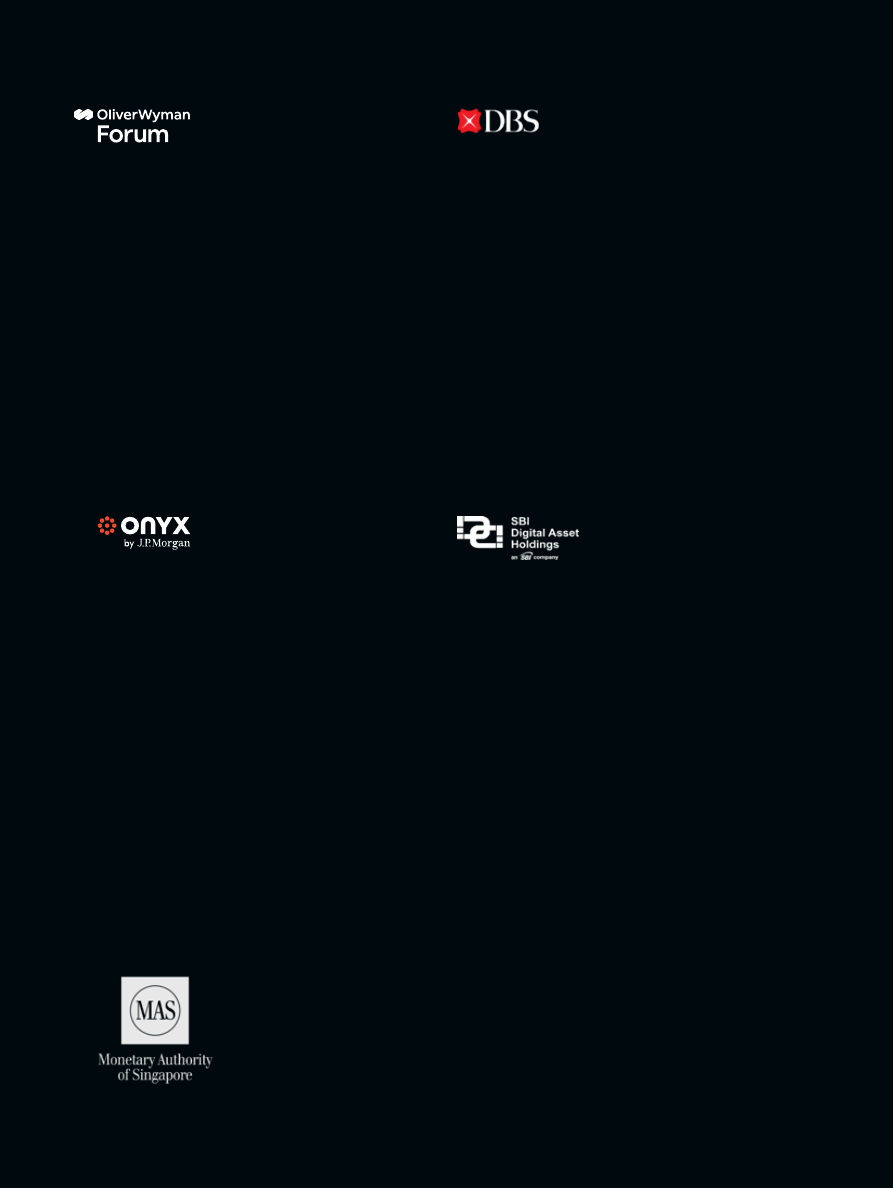
Institutional
DeFi
The Next Generation of Finance?

Institutional
DeFi
The Next Generation of Finance?

The Oliver Wyman Forum is committed to bringing
together leaders in business, public policy, social
enterprises, and academia to help solve the world’s
toughest problems. The Oliver Wyman Forum strives to
discover and develop innovative solutions by conducting
research, convening leading thinkers, analyzing
options, and inspiring action on three fronts: Reframing
Industry, Business in Society, and Global Economic and
Political Change. Together with our growing and diverse
community of experts, we think we can make a difference.
For more information, visit www.oliverwymanforum.com
Recognised for its global leadership, DBS has been named
“World’s Best Bank” by Global Finance, “World’s Best
Bank” by Euromoney and “Global Bank of the Year” by The
Banker. The bank is at the forefront of leveraging digital
technology to shape the future of banking, having been
named “World’s Best Digital Bank” by Euromoney and the
world’s “Most Innovative in Digital Banking” by The Banker.
In addition, DBS has been accorded the “Safest Bank in
Asia“ award by Global Finance for 14 consecutive years from
2009 to 2022.
DBS provides a full range of services in consumer, SME and
corporate banking. As a bank born and bred in Asia, DBS
understands the intricacies of doing business in the region’s
most dynamic markets.
For more information, please visit www.dbs.com.
Onyx by J.P. Morgan is at the forefront of a major shift
in the financial services industry. We are the first global
bank to offer a blockchain-based platform for wholesale
payments transactions, helping to re-architect the way
that money, information and assets are moving around
the world.
We work with large institutions, corporations and fintechs
who are interested in leveraging innovative technology
solutions to help solve real-world business problems at
scale. We have re-architected the infrastructure of value
transfer, using intelligent, real-time networks to help
unlock the potential of distributed ledger technology.
Institutions around the world work with us through
secure, open collaboration platforms that integrate
quickly and seamlessly across global markets.
Please visit www.jpmorgan.com/onyx for more
information.
SBI DAH endeavors to bring innovation to the financial
industry by building an ecosystem for issuance, custody,
management, and liquidity for digital assets. SBI DAH
has investments in key portfolio companies including
Sygnum, Boerse Stuttgart Digital Exchange among others
and leverages the SBI group’s broader global network of
subsidiaries and investments. Through SBI Digital Markets
and AsiaNext (a JV with the Swiss SIX group), two key
subsidiaries in Singapore, the group is growing its presence
in the region to help shape the digital asset ecosystem.
The SBI Group is a leading financial conglomerate based in
Japan. The SBI Group’s core businesses include Financial
Services Business, Asset Management Business, Private
Equity, Crypto-asset Business, and non-financial business.
Please visit www.sbidah.com and www.sbigroup.co.jp for
more information
The Monetary Authority of Singapore (MAS) is the central bank of Singapore. It seeks to
promote sustained and non-inflationary growth of the economy as well as foster a sound
and progressive financial services sector. Besides managing Singapore’s official foreign
reserves and the issuance of government securities, MAS also supervises the banking,
insurance, securities and futures industries, and develops strategies in partnership with
the private sector to promote Singapore as an international financial centre.
For more information, please visit www.mas.gov.sg
With inputs from

Foreword
The aim of this joint report by the Oliver Wyman Forum, DBS, Onyx by J.P. Morgan,
and SBI Digital Asset Holdings is to help business executives understand the
potential benefits of adapting decentralized finance (DeFi) protocols in the finance
industry using tokenized real-world assets. DeFi protocols are self-executing
applications on a blockchain that can automate financial services such as lending
and borrowing, trading, and asset management while reducing manual involvement
from intermediaries. Such protocols have emerged rapidly, capturing billions of
assets in the crypto-asset industry, but financial institutions need to address a
number of considerations before they can use DeFi protocols at scale. We believe
a version of DeFi called “Institutional DeFi”, which combines the innovations of
DeFi protocols with the safeguards of today’s finance industry, has the potential for
growth and transformative impact. This paper explains what industry participants
need to do to achieve regulatory clarity, drive commercial adoption, and get the
greatest benefits out of Institutional DeFi for their clients and themselves.

Contents
Executive Summary
5
Section 1: The Value of Institutional DeFi
8
1.1 Tokenization is already bringing new potential to money and assets
9
1.2 DeFi protocols enable new ways to deliver financial services
12
1.3 Safeguards are the key to Institutional DeFi
14
Conclusion: Now is the time to actively explore Institutional DeFi
16
Section 2: Institutional DeFi Design
17
2.1 Start by defining objectives of Institutional DeFi solutions
17
2.2 Make design choices that fit the objectives
18
Conclusion: There is no one-size-fits-all Institutional DeFi solution
24
Section 3: Institutional DeFi Design in Action
25
3.1 Introduction of Project Guardian
25
3.2 Project Guardian Pilot One
27
3.2A – Business Objectives: What did we set out to achieve?
27
3.2B – Design Choices: What did we do to make DeFi work?
30
3.2C – Lessons Learned to date: What needs to be done to reach scale?
34
Conclusion: Institutional DeFi is feasible, but work is needed to drive adoption at scale
36
Section 4: Strategic Implications for the Finance Industry
37
4.1 How the finance industry can foster Institutional DeFi
38
4.2 Playbook for financial institutions
40
4.2A Develop a house view on DeFi
41
4.2B Decide on a participation strategy
45
4.2C Get the organization ready
48
Conclusion: Four effective moves for seizing Institutional DeFi opportunities
49
Closing Remarks
50
Authors and Acknowledgements
51
Endnotes
53

Decentralized finance (DeFi), which uses blockchain-based smart
contracts to execute a variety of financial services activities, has
seized the attention of technology developers, investors, and financial
institutions. DeFi protocols have already enabled nascent markets in
the crypto-asset industry on public blockchains, such as borrowing and
lending as well as decentralized exchanges. Imagine the potential if
the technology were to be applied to streamline transactions in foreign
exchange, equities, bonds, and other real-world assets. This will require
the creation of digital representations, or tokens, of real-world assets
to bring them onto the blockchain. The cost savings and new business
opportunities of creating a “tokenized” version of real-world assets
for transacting through DeFi protocols could be significant for issuers
and investors, as well as for financial institutions that can adapt their
technology and business models.
That’s an alluring prospect, but many DeFi protocols today are not
designed for use in mainstream finance. Firms that wish to apply
DeFi in their client offerings must incorporate the same, if not higher,
levels of safeguards and security standards that have been developed
over decades in the finance industry.
This is where we look to the idea of Institutional DeFi – a system that
combines the power and efficiency of DeFi protocols with a level
of safeguards to meet regulatory compliance and customer-safety
requirements. Many existing DeFi protocols lack identity solutions
to enable institutions to meet anti-money laundering (AML), know
Executive
Summary
5
Institutional DeFi | Executive Summary

your customer (KYC), and combatting the finance of terrorism (CFT)
requirements. Cybersecurity is another major risk, as recent high-
profile hacks demonstrate. There is also limited, if any, recourse
for investors should something go wrong. Firms need to develop
safeguards to address these challenges before DeFi protocols can
be adopted at scale in mainstream finance.
To create viable Institutional DeFi solutions that fit their purpose
and ambitions, we believe financial institutions need to make
several key design choices to implement appropriate safeguards
and drive innovation. These design choices will influence everything
from the level of privacy and efficiency in transactions to the pace of
user adoption and the extent of interoperability with other tokenized
assets. The choices lie in three critical areas: 1)
blockchain – which
underlying network to build on and what information is visible to
whom; 2)
participation – the mechanisms that determine who can
develop and access solutions, and 3)
token design– how tokens
are issued, transacted, settled, and standardized.
In an effort to advance industry thinking on these issues, the
Monetary Authority of Singapore launched Project Guardian in
May 2022. The project aims to test the feasibility of applications in
asset tokenization and DeFi while managing risks to financial stability
and integrity. Project Guardian will help MAS build a framework for
a digital asset ecosystem, develop and enhance relevant policies, and
provide direction on required technology standards. The project’s
first pilot was being led by our co-authors DBS, Onyx by J.P. Morgan,
and SBI Digital Asset Holdings. The Project Guardian pilot carried out
transactions involving foreign exchange with tokenized deposits and
separate transactions with government bonds, in each case, on a public
blockchain network, using digital identity solutions and logic adapted
from existing DeFi protocols.
The pilot demonstrated the feasibility and transformative potential of
using DeFi protocols in financial markets with appropriate guardrails.
It also validated the crucial role of two key factors in this process:
1) the use of regulated institutions to act as “trust anchors,” issuing
and verifying the credentials of participating entities to establish
the identities of transacting parties and connect with existing legal
frameworks, and 2) the need for an agreed set of technical standards
6
Institutional DeFi | Executive Summary

around business logic and token standards for interoperability.
Both are essential elements for Institutional DeFi and can be helpful
across systems and jurisdictions to drive adoption, and improve
transaction efficiency for a globally integrated finance industry.
Broader efforts are needed, however, to unlock the full potential
of Institutional DeFi and make it scalable. The Project Guardian
pilot identified seven key areas where further work is needed,
such as legal clarity, adoption incentives, and technical standards
alignment, which are detailed in section 3. We believe these areas
need joint actions from multiple parties across regulators, financial
intermediaries, clients, and other third parties, including DeFi
communities. The joint actions should address legal and regulatory
uncertainties, establish shared standards, and seek to forge a
common vision of how the industry should operate.
Given the transformative potential of Institutional DeFi, financial
institutions need to develop a playbook for getting the most value
out of it. Institutional DeFi will likely vary by jurisdiction and market
structure, and we suggest three ways financial institutions should
start responding:
Develop a house view on Institutional DeFi implications across
business portfolios. We share potential future paradigms and their
implications for key sectors.
Decide on a participation strategy to adapt existing business and
embrace new opportunities enabled by Institutional DeFi. We suggest
several questions that can help firms on their journey.
Get the organization ready to fulfill its ambitions by developing the
required capabilities. We identify three areas, including organizational
structure, delivery model, and talent strategy.
7
Institutional DeFi | Executive Summary

Section 1
The Value of
Institutional
DeFi
Financial services are built on trust and
empowered by information. This trust rests
on financial intermediaries who maintain
the integrity of records covering ownership,
liabilities, conditions, and covenants, among
other areas, across a variety of siloed ledgers
that are separate from the means they use
to communicate. As each intermediary has
a different piece of the puzzle, the system
requires much post-transaction coordination
to reconcile the various ledgers and settle
transactions. For example, many securities
transactions, particularly cross-border ones,
can take anywhere from one to four days
to settle.
Distributed ledger technology (DLT), such
as blockchain, has the potential to resolve
some of those inefficiencies by presenting
transactional and ownership information
on a single shared ledger. The growing
acceptance of tokenization, which creates
digital representations of assets such as a
stocks and bonds on a blockchain, can extend
the benefits of DLT to enable exchange and
settlement of a wide range of asset classes.
Institutions can generate further efficiency
by adopting DeFi protocols, which use
software code to automatically execute a
range of financial transactions pursuant to
present rules and conditions.
We define
Institutional DeFi as the
application of DeFi protocols to tokenized
real-world assets, combined with appropriate
safeguards to ensure financial integrity,
regulatory compliance, and customer
protection. (It is important to note that in this
joint paper we do not refer to Institutional
DeFi as institutional players participating
in crypto DeFi.) The prize for innovators
who hone this model for use in the world’s
trillion-dollar finance industry could
be substantial.
8
Institutional DeFi | The Value of Institutional DeFi

Exhibit 1: What Is Institutional DeFi
Institutional DeFi
Real-world asset tokenization
Representation of real-world
assets on a mutualized ledger,
shifting from siloed records to
a shared one viewable by all
participants
DeFi protocols
Rapidly evolving area at the
vanguard of financial
services and digital assets;
providing services on a
blockchain settlement layer;
such as lending, trading,
investments, insurance, and
asset management
Appropriate Safeguards
Controls and security
standards for investor
protection and financial
stability, for example,
Know Your Customer,
trade surveillance; using a
public blockchain could
require more safeguards
+
+
Source: Oliver Wyman Forum, DBS, Onyx by J.P. Morgan, SBI Digital Asset Holdings
1.1 Tokenization is already bringing
new potential to money and assets
Technology continually evolves and
modernizes financial services by creating
new ways of executing and recording
transactions. Each step in this evolution
brings new business opportunities. For
example, dematerialization replaced paper
certificates with digital ones in the form of
electronic book-entries, fostering the rise of
electronic payments and trading. That, in
turn, made securitization possible, which
added value to previously illiquid assets
such as mortgages.
Despite recent waves of digitization, trillions
of dollars’ worth of real-world assets are
recorded in a multiplicity of ledgers that
remain separate from messaging networks.
This means that financial intermediaries
have to record transactions on siloed ledgers
and then message each other to reconcile
their books and finalize settlement. The need
for coordination across ledgers and networks
between entities creates inefficiencies
that increase costs and risks, lengthens
settlement times, and in general adds
overhead to financial services.
The past few years have witnessed an
increased focus on blockchain technology
as a potential panacea for resolving these
inefficiencies. The promised value of
blockchain comes from combining ledgers
and networks in a way that allows multiple
parties to see the same information, hence
greatly reducing the need for reconciliation
after a trade or transaction. In addition
to creating a shared view of information
(transaction balances, ownerships, etc.),
blockchains also enable business rules and
logic to be executed and viewed with high
transparency and in a deterministic manner.
For example, lending business logic can be
codified transparently in smart contracts,
thereby enforcing adherence to rules and
automating settlement.
9
Institutional DeFi | The Value of Institutional DeFi

Exhibit 2: History of Asset and Money Representation
Physical form
Paper-based and
managed by
intermediaries
Digitized, but
distributed information
requires reconciliation
Digitized, and a single
network for both
transfer of value and
messaging
Electronic network
separate from
record-keeping
Finance
Manual servicing at
physical branches
Digital Finance
Automated services via
independent systems
Institutional DeFi
Self-executing
composable services
across network
Record keeping
Network
Financial service
innovation
Electronic form
Tokenized form
Physical venues
Source: Oliver Wyman Forum, DBS, Onyx by J.P. Morgan, SBI Digital Asset Holdings
In the process of adopting blockchain
technology, financial firms are exploring
representing real-world assets as tokens on
a blockchain. Such tokenization can reduce
settlement risk and decrease settlement
times, which typically takes one to two
days even for low-risk assets such as G10
government bonds, by enabling so-called
“atomic” settlement – the instant exchange
of two assets on the condition that assets are
simultaneously transferred. No party to a
transaction is then left waiting for delivery.
The application of smart contracts in asset
tokenization also has delivered a number
of benefits, including enhanced and new
offerings. For example, J.P. Morgan leverages
tokenization to offer intra-day repo solutions
for clients on its Onyx Digital Assets
platform, and DBS Digital Exchange offers
corporates a platform to raise capital through
the digitization of their securities and assets,
with options to offer smaller denominations.
These tokenization benefits are also
welcomed by asset managers, as 70% of
institutional investors expressed willingness
to pay extra for increased liquidity and faster
asset turnover, according to a recent survey
conducted by Celent.
1
10
Institutional DeFi | The Value of Institutional DeFi

Tokenization efforts in the industry are well under way covering both payment instruments
and assets, which creates the potential for end-to-end asset exchange on blockchain.
Tokenized payment instruments
are gaining scale through public- and
private-sector efforts
Tokenized assets
are growing as multiple pilots have validated
their feasibility and value
88
%
91
%
Of global institutional investors are
comfortable with digital representations of
cash using blockchain-based technology,
according to a 2022 Celent survey
2
Of institutional investors are interested in
investing in tokenized assets, according to
a 2022 Celent survey
11
Tokenized payment instruments are being
explored by both the public and private sector.
On the public sector side, a 2021 survey of
81 central banks by the Bank for International
Settlements (BIS) found that 90% of central banks
were investigating the potential of central bank
digital currencies (CBDCs), including 26% that
were actively developing CBDCs or conducting
pilot projects.
3
The transaction volume of China’s
digital yuan, or e-CNY, reached RMB 100 billion
($13.9 billion) at the end of August 2022,
4
nearly
three years after its launch. The European Central
Bank in September selected five companies to
develop potential user interfaces for a digital
euro; it expects to complete its investigation
on whether to launch a CBDC in October 2023.
Central banks are broadening the scope of their
CBDC experiments. As of October 2022, the BIS
was running seven CBDC projects with various
member central banks.
5
More recently, the
Banque de France announced a new project to
look at using DeFi for wholesale CBDC liquidity
management.
6
On the private sector side, privately issued
stablecoins, which are cryptocurrencies typically
pegged to fiat money such as the US dollar,
have grown to a nearly $150 billion market.
7
There are increasing efforts from regulators to
clarify the status of stablecoins. Recently, MAS
published a consultation paper to support the
development of stablecoins as a credible medium
of exchange in the digital asset ecosystem.
8
In 2022, the European Union agreed on the
first major regulatory framework for the crypto-
asset industry, including stablecoins.
9
Japan
also passed a bill providing a legal framework
for stablecoins that allows licensed banks,
money transfer agents, and trust companies
to issue them.
10
We see many firms entering the space across
multiple asset classes including equities, bonds,
real estate, commodities and others. For example,
J.P. Morgan’s intra-day repo application on
Onyx Digital Assets has processed more than
$430 billion of repo transactions since its launch
in November 2020; the daily transaction volume
of Broadridge’s Distributed Ledger Repo platform
using tokenized government bonds reached
$35 billion in the first weeks after launch;
12
DBS has successfully issued the DBS Digital
Bond in May 2021 via security token offering
(STO); Mata Capital, a French asset manager,
tokenized €350 million ($343 million) worth of
funds.
13
Last year, Switzerland implemented a
so-called DLT Act granting tokenized securities
the same legal status as traditional ones.
14
Furthermore, in May 2021, Germany’s Parliament
passed a law allowing securities to be issued in
electronic form, not paper, enabling the issuance
of tokenized assets. The European Investment
Bank subsequently issued a digital bond on a
public blockchain in 2021 under this German law.
15
11
Institutional DeFi | The Value of Institutional DeFi

1.2 DeFi protocols enable new ways
to deliver financial services
In parallel to industry efforts to develop
real-world asset tokenization, the concept
of decentralized finance has flowered in
the public crypto-asset space. DeFi, as it is
popularly known, refers to decentralized
applications (DApps), which provide
financial services via sophisticated and
automated computer code on a blockchain as
the settlement layer. These services include
payments, lending, trading, investments,
insurance, and asset management. DeFi
protocols are the code and procedures
that govern these applications. These
protocols typically operate without
centralized intermediaries or institutions,
use open-source code, and allow for flexible
composability (code or applications can
be taken from one protocol/service and
plugged into another).
DeFi has rapidly emerged in the past
three years and grew more than tenfold to
$160 billion in 2021 in terms of total value
locked before retreating to stand at a little
over $50 billion as of October 2022.
16
DeFi
innovations have flourished across various
financial ecosystems and attracted billions
of dollars of liquidity across decentralized
exchanges (such as Curve and Uniswap),
lending protocols (such as Aave and
Compound), and other DeFi solutions,
such as liquidity staking and collateralized
debt positions, which lock up collateral in a
smart contract in exchange for stablecoins.
Some noteworthy innovations in the DeFi
space involve crypto lending/borrowing
protocols and decentralized exchanges:
• Liquidity pools, for instance, create
all-to-all markets. These pools link
buyers and sellers along with liquidity
providers in decentralized exchanges,
or DEXes, and lenders and borrowers in
lending protocols. Aave and Compound
are examples of large crypto lending
and borrowing protocols in terms of
total value locked,
17
whose operations
involve liquidity pools. Both retail and
institutional investors can deposit, borrow,
or trade crypto from the pool using
business logic that is governed by smart
contracts. If pools are on the same chain
or made interoperable, this aggregates
liquidity by attracting more investors.
• Automated market markers (AMM) provide
a new method of price discovery. An AMM
facilitates buy and sell orders in a self-
executing manner, always standing ready
to provide quotes and setting a price based
on a predefined, transparent formula
considering supply and demand. Uniswap
and Curve are examples of a decentralized
crypto exchange that uses an AMM. When
a user wants to swap crypto A for crypto
B, the AMM automatically calculates how
much crypto B the user can get and at
what price rather than relying on a market
maker to quote a price or to match a buyer
and a seller.
12
Institutional DeFi | The Value of Institutional DeFi

DeFi, as described above, is prevalent in the
public blockchain space and applies mostly
to transactions in the largely unregulated
crypto-asset industry. Yet the logic
embedded in DeFi protocols, which are
programmable, self-executing business
processes, can be applied to interact with
any tokenized asset.
Building full-scale financial services that
leverage tokenization and programmability
could have far-reaching implications for
the finance industry. It could generate
substantial cost savings, as code dramatically
reduces middle and back-office operations
across firms and intermediaries. In
the exhibit below we list some notable
benefits of DeFi solutions. New business
opportunities are also likely to emerge as
financial institutions take advantage of the
composability of DeFi protocols, packaging
multiple DeFi protocols together to offer
new solutions. First, however, firms must
adapt the DeFi protocols to the regulatory
standards of today’s trillion-dollar markets
for money, stocks, bonds, and other assets.
Exhibit 3: Notable Benefits of DeFi
Atomic settlement reduces risk by providing a secure way to deliver securities for payment
Mutualized and transparent ledgers facilitate real-time value movement, cheaper settlement
Composable nature (ability to interact with one another) of DeFi protocols
allows for seamless collaboration across multiple services
Interoperability across asset classes and markets aggregates liquidity
and enables a more globally integrated finance industry
Programmable logic allows automation of multi-party operational activities and thus
reduces middle- or back-office overhead such as transfers and post-trade reconciliation
Transparent and automated business logic enables new product features,
such as liquidations for collaterals and new product offerings
Innovative DeFi solutions amplify liquidity of tokens and tokenized real-world assets,
given lower participation threshold, such as decentralized exchanges
Source: Oliver Wyman Forum, DBS, Onyx by J.P. Morgan, SBI Digital Asset Holdings
13
Institutional DeFi | The Value of Institutional DeFi

1.3 Safeguards are the key to
Institutional DeFi
Today’s finance industry rests on an
array of safeguards that protect investors
from fraud and abusive practices, combat
financial crime and cyber malfeasance,
maintain investor privacy, ensure that
industry participants meet certain minimum
standards, and provide a mechanism
for recourse in case things go wrong.
Institutional DeFi will need to incorporate
the same, if not higher, level of standards to
meet regulatory requirements, create trust,
and drive adoption by issuers, investors,
and financial institutions.
Here are some of the key safeguards needed
to build DeFi-based solutions for institutions:
• AML/KYC risk controls. Mechanisms
that ensure AML/KYC compliance for
participants can avert the potential legal
liability of dealing with sanctioned parties
or unqualified investors, and also prevent
inadvertently enabling or participating in
money laundering. Designing appropriate
risk controls however are not easy. In
2021, financial institutions were fined
$2.7 billion for their deficiencies and
failures in AML compliance policies,
procedures, and processes.
18
To avoid
the severe consequences that could
arise from control failures, the average
mid-size to large organization spends
$22.7 million annually on financial
crime compliance operations to build up
effective standards.
19
Appropriate controls
are needed if regulated financial activity is
to take place through DeFi protocols, and
regulators have begun to set expectations.
In August 2022, the U.S. Department of
the Treasury’s Office of Foreign Assets
Control (OFAC) imposed sanctions on
Tornado Cash, a cryptocurrency mixer
that facilitates anonymous transactions
by obfuscating their origin, destination,
and counterparties, alleging that it had
facilitated the laundering of more than
$7 billion worth of cryptocurrency.
20
Blockchain technologies may offer novel
ways of ensuring appropriate controls
at lower cost. For example, there are
methods for ensuring compliance with
AML/KYC without necessarily revealing
one’s personal information, such as using
zero-knowledge proofs combined with
pseudonymous identity mechanisms.
• Data privacy. Data privacy is crucial for
clients in certain segments, in particular to
protect their trading history and positions
for certain asset markets. Information on
public blockchains is permanently visible
to all by default, and investor orders can at
times be inferred from publicly available
data, something that becomes increasingly
more likely as time goes on and data
is accumulated. For example, whale
tracking tools on Twitter and Telegram
are widely used by the public to track
large crypto-asset transactions done via
decentralized exchanges and other DeFi
protocols, whereby people have strong
assumptions or hypotheses on who these
whales (investors holding a vast number
of crypto-assets) are.
21
In the finance
industry, client information in respective
transactions is masked and protected
through brokers, without being revealed
to the market. Appropriate privacy
protections will be necessary.
• Cybersecurity protections. While
almost anything digital can be vulnerable
to hackers, cybersecurity protections
are especially important for digital
assets and DeFi protocols due to the
nature of blockchain. Although the
14
Institutional DeFi | The Value of Institutional DeFi

underlying blockchain technology
makes it difficult to alter data, firms
seeking to develop Institutional DeFi
solutions must address cybersecurity
vulnerabilities in cross-chain bridges,
private digital keys, and on-chain price
oracles, as well as guarding against market
manipulation. Such controls are needed
to enhance client trust and protect the
safe ownership of digital assets. A rise
in thefts from DeFi protocols led to a
58% increase in crypto hacking losses,
to $1.9 billion, in the first seven months
of 2022.
22
Bridges connecting different
networks are particularly vulnerable, as
hackers demonstrated in July 2021 by
attacking the cross-chain DeFi platform
Poly Network, and causing roughly $600
million in losses in Ethereum and other
tokens.
23
Users manage their own private
keys to access their crypto assets, which
can also compromise security. Losses due
to compromised private keys have totaled
$274 million in the first eight months of
2022 alone.
24
• Mature governance and conduct
models. Reliable DeFi protocol
governance and stakeholder conduct
standards are needed to ensure that the
quality of Institutional DeFi solutions
offered are in alignment with financial
services professional standards. Financial
institutions are highly regulated with
mature quality assurance processes.
For example, there are more than nine
different federal financial regulators in the
United States on top of multiple regulators
in each of the 50 states.
25
Multilateral
organizations help coordinate financial
regulation internationally. Banks invest
over $270 billion a year and dedicate an
average of 10% to 15% of their staff to
comply with regulatory obligations.
26
Standards for conduct exist for both
institutions and individuals. Existing
DeFi protocols are based on different
governance and conduct assurance
mechanisms, most often done through
governance tokens that bestow holders
with voting rights. This is similar to most
common equity structures but without
the same level of corporate governance.
Also, many DeFi protocols have a very
high concentration of voting control:
Research by Chainalysis into 10 major
governance tokens found that fewer
than 1% of token holders held 90% of
the voting rights.
27
Indeed, participants
could consider whether to and how to
cover DeFi protocols under a corporation
construct – such as trusts, special purpose
vehicles, or other limited purpose
corporations – to allow for structured
governance and liability recourse.
• Proper recourse mechanisms. Recourse
and dispute management should be
properly established upfront. Incidents
such as theft or loss due to operational
errors can occur in any financial system.
The finance industry today is built with
robust recourse mechanisms or legal
remedies to protect users and investors
in most cases. For instance, the London
Court of International Arbitration, one of
the world’s leading arbitral institutions,
managed 86 international dispute cases
from the banking and finance industry
in 2021.
28
Such mechanisms are lacking
in public DeFi solutions, giving rise to
uncertainty in arbitration procedures.
When a hacker stole $130 million in
crypto assets from users of DeFi platform
BadgerDAO, they were unable to afford
full restitution immediately with a mere
$53 million in their treasury and no
insurance coverage.
29
Without an available
legal recourse mechanism, this left a
handful of affected users uncompensated.
• Legal clarity around smart contract-
based business activity. The legal status
of financial business activity has been
15
Institutional DeFi | The Value of Institutional DeFi

continuously clarified by countless acts
of legislation and major litigation efforts
over past decades. The UK High Court,
for example, typically hears 80 to 100
important banking and finance cases
annually.
30
That level of clarity does not
yet exist for smart contract-based DeFi
activity. According to international law
firm Norton Rose Fulbright, it remains
unclear which smart contracts are legally
enforceable, which could depend on
the intentions of contracting parties or
local jurisdictions.
31
In the United States,
the enforceability and interpretation of
contracts in the United States is commonly
governed by state law. Some states such
as Arizona and Nevada have amended
their respective laws (such as the
Uniform Electronic Transactions Act)
to explicitly incorporate blockchains
and smart contracts.
32
Some code-only
smart contracts would be enforceable
under state laws governing contracts.
The International Swaps and Derivatives
Association (ISDA) also developed
legal guidelines for smart derivatives
contracts to provide general guidance
for different jurisdictions.
33
More legal
clarity in commercial law is necessary to
reinforce these requirements and foster a
trusted environment for smart contract-
based business.
Conclusion
Now is the time to actively explore Institutional DeFi
The foundation for Institutional DeFi is being established by the growth
of real-world asset tokenization and the innovations observed in DeFi.
Financial institutions have the opportunity to transform parts of their
business by adapting DeFi protocols and combining them with the level
of safeguards that regulators and clients expect. Institutional investors’
appetite for digital assets is growing and they are willing to pay extra
for increased liquidity and faster transactions. 88% said they are still
planning to move forward with current plans around digital assets
despite market downturn.
34
In May 2022, the Monetary Authority of Singapore launched Project
Guardian to test the feasibility of applications in asset tokenization and
DeFi while managing risks to financial stability and integrity. Project
Guardian will help MAS build the digital asset ecosystem framework,
enhance and develop relevant policies, and provide direction on the
technology standards. Sections 2 and 3 of this report will explore how
financial services providers could adopt Institutional DeFi based on
different considerations, leveraging findings from the first pilot under
Project Guardian. Section 4 will discuss how financial institutions
should collaborate to get the most out of the transformation.
16
Institutional DeFi | The Value of Institutional DeFi

Section 2
Institutional
DeFi Design
While Institutional DeFi has potential,
financial institutions need to consider areas
where tokenization and programmability
are most valuable, and tailor DeFi protocols
for their purposes accordingly instead of
simply reusing what works in the crypto-
asset industry.
2.1 Start by defining objectives of
Institutional DeFi solutions
Institutions interested in exploring
Institutional DeFi solutions should start by
asking themselves, “why DeFi?” The answer
will depend on the commercial viability,
adoption feasibility, and competitive
advantage of such a solution. Objectives
could range from creating new products and
reducing data reconciliation tasks, to cutting
costs and speeding up settlement times.
Firms also need to consider a number
of broader objectives when designing
Institutional DeFi solutions. These
should include:
• Ecosystem objectives, such as
encouraging widespread adoption by
providing seamless interconnectivity to
and compatibility with existing trading
systems, preparing for interactions
with upcoming CBDC frameworks, and
fostering an open innovation environment
that encourages the development of
market-driven solutions
• Protection objectives, such as ensuring
compliance with the existing legal and
regulatory frameworks, allowing access
to only qualified users, and mitigating
various financial and operational risks,
including cybersecurity risks.
17
Institutional DeFi | Institutional DeFi Design

2.2 Make design choices that fit the
objectives
After firms have established their objectives,
they need to make choices in three key areas:
1)
blockchain – which underlying network
to build on and what information is visible to
whom; 2)
participation – the mechanisms
that determine who can develop and access
solutions; and 3)
token design – how
tokens are issued, transacted, settled,
and standardized.
It is critical that firms weigh the options and
their associated trade-offs carefully, as these
design choices are paramount in influencing
how the offerings achieve their objectives.
Exhibit 4: The Three Key Design Choices
Deployment
Access & usage
Token
issuance
Token
standards
Settlement
recognition
Network type
Data security & visibility
Binary choice
Spectrum of options
Participation
Token Design
Blockchain
Source: Oliver Wyman Forum, DBS, Onyx by J.P. Morgan, SBI Digital Asset Holdings
:
18
Institutional DeFi | Institutional DeFi Design

Exhibit 5: The Three Key Design Choices – Blockchain
Blockchain
Blockchain refers to the type of network used, along with the level of data security and privacy.
Public
permissionless
Public
permissioned
Network type
Transparent
Private
Data security & visibility
Spectrum of choice
Network type
Network type refers to the underlying
network and database used to deploy an
Institutional DeFi solution with asset tokens.
This design choice is critical because it
affects so many important design objectives,
such as user access, interoperability, and
the strength of the developer ecosystem.
Public permissionless networks, such as
Ethereum and Polygon, impose no restriction
on access, and therefore have the potential
to encourage wider participation. They are
better equipped to facilitate interoperability
with existing digital assets and DeFi
protocols, which are on public permissionless
networks. There is already a wide base of
DeFi developers and open-source code that
have been tested and deployed on public
permissionless networks. This helps kickstart
and facilitate continued innovation, using
software components and applications that
are leverageable and composable. On the
flipside, this openness is also a potential
source of risk unless additional safeguards
are put in place.
Public permissioned networks, on the other
hand, can facilitate the use of controls
to authorize user access and restrict the
visibility of transactions on these networks.
This enables easier implementation of checks
and balances, along with traceability for
investigation purposes. As Institutional DeFi
models are still being explored, it is possible
a public permissionless blockchain could be
modified to ensure it is usable at scale by
institutional participants.
19
Institutional DeFi | Institutional DeFi Design

Data security and visibility
This informs the level of data transparency
of the solution, and its implied level of
data security. Data transparency is itself
a multifaceted concept and the choices
vary along a spectrum. On one end of the
spectrum, all transaction data is transparent
and available for all participants to view,
as is common with many public blockchains
today. On the other end of the spectrum,
participants may access only data relating
to their own transactions. Function-level
access management can provide different
levels of access to users, while encrypting
data and providing a viewing key to
selected participants can enable authorized
viewership. Moreover, different techniques,
such as zero-knowledge proofs (ZKP) and
ensuring DeFi protocol uses only private
messages, can be implemented for data
privacy on public blockchains.
The choice of transparency level
primarily depends on the solution’s value
proposition – but data ideally should be
private while discoverable to customers
or authorized stakeholders (such as
regulators). For example, the preferred
approach for a central limit order book-based
venue may be to make order and transaction
data available, while a dark pool solution may
prefer to conceal order information.
Mechanisms for data management and
protection need to be properly designed to
comply with regulatory data requirements
to prevent issues introduced by DeFi such as
maximal extractable value (MEV), where each
of the validators or “miners” updating the
blockchain can determine which transactions
are executed and when, thus affecting market
prices and opening the door to front-running
and other forms of market manipulation.
35
This is especially important for solutions on
the public blockchain as data is permanently
and immutability recorded on a publicly
available ledger, introducing a higher risk
of loss of privacy.
20
Institutional DeFi | Institutional DeFi Design

Exhibit 6: The Three Key Design Choices – Participation
Fully open
Assurance-based
Deployment
Permissionless
Permissioned
Access & usage
Spectrum of choice
Spectrum of choice
Participation
The choice of participation mechanism for an Institutional DeFi solution is nuanced and never binary.
There is a spectrum of choice regarding protocol deployment and access and usage.
Deployment
This choice governs how new smart
contracts and protocols are developed
and deployed, and embodies different
approaches to innovation and risk. On one
end of the spectrum, in a fully open model,
anyone can develop and deploy smart
contracts. This lowers barriers for application
development and encourages competition,
but it also entails risk as there are fewer
checks and balances before protocols are
deployed. This is not to say that assurance
standards are not used. For example,
some DeFi protocols today make use of
code audits. But such standards are not
mandated nor instituted for deployment.
On the other end of the spectrum, in an
assurance-based model, control and review/
approval mechanisms are put in place to
ensure adherence to specific standards
before deployment. These can be industry
standards widely accepted by institutional
investors and clients or standards instituted
through regulatory requirements. One
approach is to allow only selected developers
or firms to develop new processes. Another
approach is to ensure specific checks are
made to protocols, allowing only verified
protocols to be deployed.
21
Institutional DeFi | Institutional DeFi Design

Access and usage
This design choice relates to how controls
are put in place to manage user access and
usage. Restrictions can be imposed at the
service level (such as by controlling who
can access a liquidity pool) or at the level
of underlying functions (for example, by
controlling trading permissions, such as
instrument types and ticket size).
A permissionless participation model is
one where anyone can access the DeFi
protocols and use all functions without
restrictions (such as the Uniswap DEX),
while a permissioned participation model
is one where only authorized or verified
participants can access specific services
and use selected functions. While a
permissionless participation model could
help maximize the potential userbase and
foster growth, a permissioned participation
model helps comply with regulatory
requirements (such as KYC, qualified access)
by ensuring only the right participants can
use the appropriate functions. Note that a
permissioned model can still be enabled
on a public permissionless blockchain,
via access management mechanisms.
22
Institutional DeFi | Institutional DeFi Design

Token issuance
Non-native tokens are issued to represent
existing real-world assets. These non-native
tokens are bound to existing off-chain
processes and control mechanisms, such as
custody and reconciliation. For example, on
the Onyx Digital Assets platform, securities
accounts holding US Treasuries maintained
by J.P. Morgan for the benefit of its clients
are tokenized to enable intraday repo
transactions. On the other hand, real world
assets can be issued directly on a blockchain
as native tokens, such as through security
token offerings (STO). It is worth noting that
asset tokenization is rapidly evolving, and
there may be more ways to issue tokens in
the future.
There is currently legal uncertainty involved
for both native and non-native tokens.
Depending on the nature of the native token’s
asset class, there can be a lack of legal clarity
on whether such native tokens can exist by
themselves and rely on the blockchain alone
for record of its existence. For example,
bonds in the EU have to be registered with
a central securities depository (CSD), and
having a natively issued bond token without
separately registering with the CSD may not
meet such requirement. We note that this
leaves space for innovation in regulation
as well as the creation of blockchain-native
CSDs and similar actors. For non-native
tokens, there are considerations such as on-
chain settlement finality, which we discuss
in the next sub-section.
Both non-native tokens and native tokens
can interact with DeFi protocols, allowing
for automatic execution of asset servicing
and transactions without the need to rely on
legacy systems. However, transactions with
non-native tokens may ultimately require
interactions with off-chain processes as
noted above. The choice of token issuance
will depend on the nature of the asset which
is intended to be reflected, whether such
asset requires linkage to an off-chain asset,
Exhibit 7: The Three Key Design Choices – Token Design
Non-native
Native
Token issuance
n/a
n/a
Token standards
Choice of standards
Token Design
This refers to how a token is issued, transacted, settled, and standardized.
On-chain
settlement
Off-chain
settlement
Settlement recognition
23
Institutional DeFi | Institutional DeFi Design

whether blockchain ledgers may serve as the
determinative books and records in respect of
the issuance and ownership of such asset, and
whether there is the desire or need to tokenize
an existing asset that lives in legacy off-
chain systems.
Settlement recognition
Settlement recognition depends on whether
or not a token transfer on-chain is recognized
by law, regulation, or contractual arrangement
as a final transfer. This is a notable issue for
consideration in respect of non-native tokens,
where additional steps may be required to
be taken with respect to the off-chain asset
being represented. However, as noted above in
respect of CSD registration requirements, this
issue may arise due to regulation in respect of
native tokens as well. Off-chain settlement is
when a token transfer is not recognized as a
transfer of the underlying asset. In this case,
settlement finality is recognized off-chain,
in which an off-chain ledger is updated to
reflect ownership change. On-chain settlement
is when settlement finality is recognized
on-chain, whereby the on-chain ledger is
recognized as the single source of truth for
transfer and ownership.
The determination as to whether settlement
can be recognized on-chain mainly depends on
whether regulators and transaction participants
can legally recognize the blockchain records
as the final books and records of transactions,
allowing the blockchain to function also as
a de facto ownership ledger. This requires
an understanding of the regulation and
commercial law applicable to the transaction at
issue, as well as any contractual arrangements
in place. The analysis here will determine
whether transactions need to rely on legacy
ledgers and processes, or whether legacy
systems can be entirely replaced.
Token standards
Token standards are the set of principles on
which tokens are issued and smart contracts
are developed. These standards influence
the ability to interact with different DeFi
protocols, and hence the interoperability and
functionality, of the asset tokens. Different
public standards might be appropriate
depending on the type of token to be issued.
For example, the ERC-721 standard is designed
for non-fungible tokens (NFTs) while ERC-
1155 is suitable for both fungible and non-
fungible tokens and can be explored for
tokenized assets.
Conclusion
There is no one-size-fits-all Institutional DeFi solution
Design choices for Institutional DeFi solutions need to be tailored
for specific, prioritized business objectives. However, a specific
design choice may help achieve one business objective while imposing
limitations on another. As such, the task for any firm considering an
Institutional DeFi solution is to choose a complementary set of options
within each design choice to address its business objectives, taking into
account asset classes, jurisdictions, and the target value proposition.
24
Institutional DeFi | Institutional DeFi Design

Section 3
Institutional
DeFi Design in
Action
Experimentation is crucial to understanding
different approaches to Institutional DeFi.
Finance industry participants around the
world are increasingly conducting pilots
and experiments to explore different design
objectives and choices.
This report draws on the hands-on
experience of the co-authors in running
a joint pilot under Singapore’s Project
Guardian. The Monetary Authority of
Singapore (MAS) launched this collaborative
initiative with the financial services industry
to explore the economic potential and
value-adding use cases of asset tokenization
and DeFi. Using a controlled, sandbox
environment, it aims to test the feasibility
of applying asset tokenization and DeFi
protocols, while managing financial
stability and integrity.
3.1 Introduction of Project
Guardian
Project Guardian is designed to help MAS
build a digital asset ecosystem framework,
develop and enhance relevant policies, and
provide direction on technology standards.
Project Guardian will test the feasibility of
applications in asset tokenization and DeFi,
while managing risks to financial stability
and integrity. The central bank aims to
develop and pilot use cases in four main
areas (see next page).
25
Institutional DeFi | Institutional DeFi Design in Action

Exhibit 8: Project Guardian objectives
Open, interoperable networks
Avoid fragmented and private
exchanges or markets
Asset tokenization
Ensure operational feasibility of
asset tokens
Institutional-grade DeFi protocols
Mitigate market manipulation
and operational risks
Trust anchors
Ensure trading with verified,
trusted counterparties
Open, interoperable networks
Explore the use of public blockchains to
build open, interoperable networks that
enable digital assets to be traded across
platforms and liquidity pools. This includes
interoperability with existing financial
infrastructure. Open, interoperable networks
can mitigate against the formation of
walled gardens in digital exchanges and
fragmented private markets.
Trust anchors
Establish a trusted environment for the
execution of DeFi protocols through a
common trust layer of independent trust
anchors. Trust anchors are regulated
financial institutions that screen, verify,
and issue Verifiable Credentials to entities
that wish to participate in DeFi protocols.
This ensures that participants interact only
with verified counterparties, issuers, and
protocol developers.
Asset tokenization
Examine the representation of securities
in the form of digital bearer assets and the
use of tokenized deposits issued by deposit-
taking institutions on public blockchains.
The project aims to build upon existing
token standards, incorporate trust anchor
credentials, and enable asset-backed tokens
to be interoperable with other digital assets
used in DeFi protocols on open networks.
Institutional-grade DeFi protocols
Study the introduction of regulatory
safeguards and controls into DeFi protocols
to mitigate against market manipulation
and operational risk. The project will also
examine the use of smart contract auditing
capabilities to detect code vulnerabilities.
Source: Monetary Authority of Singapore
26
Institutional DeFi | Institutional DeFi Design in Action

3.2 Project Guardian Pilot One
In the first pilot, our co-authors gained
first-hand experience in implementing DeFi
solutions in the financial markets, including
foreign exchange and government bond
markets. This section details the pilot’s
business objectives, design choices, and
the lessons learned to date.
3.2A – Business Objectives:
What did we set out to achieve?
Pilot One was led by co-authors DBS,
Onyx by J.P. Morgan, and SBI Digital Asset
Holdings. It sought to determine whether
tokenized real-world assets and deposits
could be transacted on a public blockchain
leveraging DeFi protocols, in a compliant
manner that preserves financial stability
and integrity. The intent was to explore the
delivery of traditional financial services
in a more open manner, fostering broader
participation in foreign exchange and
government bond markets through an
open and efficient ecosystem that attracts
liquidity providers and liquidity takers.
There were two workstreams in this pilot to
ensure comprehensiveness. Workstream one
focused on foreign exchange transactions
using SGD tokenized deposits issued by
J.P. Morgan and JPY tokenized assets
issued by SBI Digital Asset Holdings,
36
and
workstream two focused on the trading of
foreign exchange and government bonds
using tokenized cash (deposit) and tokenized
securities between entities of DBS and
SBI Digital Asset Holdings.
37
Transactions
under both workstreams were conducted
on public blockchain main net, focused on
technical and operational feasibility, and
participants established bilateral terms
and other controls to avoid actual financial
impacts, such as planned trade unwinding
for workstream one.
To fully assess the efforts needed for the
implementation of Institutional DeFi, the
pilot went through the complete lifecycle
from trade order placement, to trade
execution, token settlement and clearing.
Relevant business and operational teams
from front office to back office were
involved to assess potential gaps ahead
of the potentially scaled implementation
of Institutional DeFi, reducing adoption
friction and encouraging internal buy-
in. Transactions were executed using
modified public DeFi protocols and
leveraged Verifiable Credentials issued by
trust anchors to ensure transactions were
executed in a safe and compliant manner.
We illustrate the design choices made under
the four focus areas (see next page).
27
Institutional DeFi | Institutional DeFi Design in Action

Exhibit 9: Project Guardian Pilot Setup
Open, interoperable networks
Avoid fragmented and private
exchanges or markets
Pilot
Tokenized deposits & bonds
Issue and transfer tokenized assets
using a public blockchain
Pilot
Refined DeFi protocols
Adapt open-sourced protocols to
effect transaction terms
Pilot
Public blockchain
Deploy solution on public blockchain
for transactional activities
Pilot
Verifiable credentials
Issue digital Issue digital identities to
trade only with verified counterparties
Asset tokenization
Ensure operational feasibility of
asset tokens
Institutional-grade DeFi protocols
Mitigate market manipulation
and operational risks
Trust anchors
Ensure trading with verified,
trusted counterparties
Source:
Oliver Wyman Forum, DBS, Onyx by J.P. Morgan, SBI Digital Asset Holdings
• A public blockchain, Polygon was
selected for its potential to allow higher
interoperability of tokenized real-world
assets and DeFi protocols, which allowed
participants to develop their own solutions
based on a set of agreed upon technical
standards.
• Trust anchors were developed to
ensure all trades were conducted within
a controlled, trusted environment. W3C
Verifiable Credentials issued by trusted
financial institutions were used to enable
compliant access to the DeFi protocols.
Verifiable Credentials consisted of tamper-
resistant information (identifiers and
metadata) that cryptographically attested
to the identity of the entity/person using
them. These credentials were developed
using W3C standards to reinforce Project
Guardian’s interoperability objective.
• The pilot leveraged tokenized assets
created by the co-authors across two
workstreams. In workstream one, Onyx
by J.P. Morgan focused on tokenized
Singapore dollar (SGD) deposits and
SBI Digital Asset Holdings focused on
tokenized Japanese Yen (JPY) assets.
In workstream two, DBS focused on
28
Institutional DeFi | Institutional DeFi Design in Action

tokenized SGD deposits and tokenized
Singapore Government Securities
(SGS), and SBI Digital Asset Holdings
focused on tokenized JPY deposits and
tokenized Japanese Government Bonds
(JGB). Our co-authors played unique
roles to complete bilateral trades within
these workstreams.
• Participants used modified public DeFi
protocols to conduct the transactions –
a lending and borrowing protocol (Aave)
was applied to a foreign exchange use case
in workstream one, and a decentralized
exchange protocol (Uniswap) was applied
to the trading of foreign exchange and
government bonds.
The pilot found that DeFi protocols have
potential to be adapted and tailored for
foreign exchange and government bond
markets activities on a public blockchain.
Further details of the pilot will be explored
in subsequent sub-sections. Continuous
improvements and testing of solutions are
on the horizon to better serve participants’
circumstances, needs and objectives. The use
of specific protocols by the pilot participants
does not constitute an endorsement of such
protocols by any author of this report. The
participants will continue to experiment,
both adapting existing protocols and building
new ones. Independent judgment should be
exercised in selecting an appropriate protocol
to suit any individual’s or organization’s
circumstance, needs, or objectives.
29
Institutional DeFi | Institutional DeFi Design in Action

3.2B – Design Choices: What did
we do to make DeFi work?
Among multiple design aspects, our co-
authors believe at least two were critical:
1) a trusted method to establish identity
for financial institutions to participate in
transactions against known and attested
counterparties on a public blockchain,
and 2) alignment on technical standards
underpinning interactions on the public
blockchain, using tokenized deposits
and assets.
1.
A trusted compliant method:
Trust anchors and Verifiable Credentials
were used to authenticate identity and
connect with existing legal frameworks.
Trust anchors were regulated financial
institutions that verified and issued
Verifiable Credentials to participating
traders, enabling them to transact on the
public blockchain. The trust anchors can
be viewed as the universal trust layer,
providing participants with a compliant
gateway to the Institutional DeFi solution.
The implementation of the trust anchor
mechanism was flexible and could
vary across institutions. For example,
authorized traders were issued credentials
by their parent institutions, through
various internal processes and credential
issuing software. These credentials were
attached to trade instructions to the DeFi
pool, and on-chain verification of these
credentials ensured that only instructions
with legitimate credentials were forwarded
to the DeFi pool.
2.
Alignment on technical standards:
Standards such as ERC-20 and W3C were
used to allow potential interoperability
among pilot participants.
The participants aligned on technical
standards to allow interoperability
between specific DeFi protocols and
existing legacy off-chain systems.
Interoperability also drove the choice
towards the use of ERC-20, the most-
common token standard in the Ethereum
ecosystem, to define token ownership,
supply, type of issuance, and data to
be stored on-chain, such as the token
name and ticker. Moving forward,
there may be other standards such as
ERC-1155 that could better represent
traditional instruments on-chain and
for trading. The Verifiable Credentials
were developed based on W3C standards
to enable participants to transact in a
compliant manner on a modified version
of the permissioned Aave protocol on the
Polygon network.
30
Institutional DeFi | Institutional DeFi Design in Action

Exhibit 10: Summary of Project Guardian Design Choices
Design choice
Rationales (non-exhaustive)
Blockchain
Network type Polygon
(public blockchain)
• Compliant with Ethereum Virtual Machine and could potentially
inherit data availability and security provided by Ethereum
Layer 1
• Strong developer ecosystem; Open-source DeFi protocol
resources available for feasibility assessment and rapid
development
• Instances of institutional participation on the network (or in
the ecosystem)
• Use of proof of stake (PoS) consensus ensuring less energy
consumption in validation
Data security
and visibility
Only wallet address
disclosed with
identity kept
confidential.
Transaction data
stored in public
blockchain with no
details disclosed
to non-participants
• Fulfil the purpose of pilot and experiment data security and
visibility on public blockchain to prepare for scalable adoption by
the industry
• Minimize identifiable data on-chain in a controlled environment
to avoid leakage of confidential data to public during the Pilot
31
Institutional DeFi | Institutional DeFi Design in Action

Participation
Deployment
Assurance-based
model, authorizing
only pilot participants
to deploy modified
open-source smart
contracts, such
as permissioned
version of Aave,
to interact with
other participants
• Developers are limited to pilot participants, who are known
regulated entities and individuals
• Institutional-grade development standards were applied to
aid client protection, such as smart contract audits, Verifiable
Credentials of the participants, and product/code management
process
• Potential for rapid parallel developments by leveraging
composable DeFi protocols, reducing time and cost of innovation
Access
and usage
Trust anchors
verify and authorize
participants, using
W3C-based Verifiable
Credentials (VCs)
• Participant firms function as trust anchors to run Verifiable
Credentials (VCs) issuance software to issue VCs to
authorized traders
• VCs were held by traders in custom-built wallets. The wallets
enabled VCs to be attached to trade instructions and on-chain
verification ensured only instructions with legitimate credentials
were accepted
• The smart contract system was designed to enable use of VC
verification without requiring the DeFi protocols to be aware of
the actual credentials, thereby enabling the use of this system
with a wide variety of DeFi protocols “out of the box” for future
scaled adoption. The verification of VCs was done on-chain by
smart contracts before being forwarded to the DeFi pool
• The issued credentials followed a chain of trust, every authorized
trader credential (including various control mechanisms such as
trading limits) was irrevocably anchored to a trusted entity
• Traders never had direct access to firms’ funds. The solution
enabled verification of traders’ identities on chain, based on
which they were authorized to trade on the application
• These Verifiable Credentials could be revoked. Upon revocation,
traders would be prevented from trading
• The use of W3C open standards ensured that the implementation
aligned with Project Guardian’s interoperability objective
32
Institutional DeFi | Institutional DeFi Design in Action

Token Design
Token
issuance
Multiple issuance
approaches were
taken, such as
• DBS issuing
tokenized SGD
and non-native
Singapore
Government
Securities
(SGS) tokens
• J.P. Morgan issuing
native Singapore
dollar deposits
(SGD) tokens
• SBI issuing non-
native Japanese
Government Bonds
(JGB) tokens
• The use of tokenized form enables interactions with DeFi
protocols for real-world assets, and the use of different token
issuance approaches can test the interoperability of tokens
issued by different mechanisms and players, e.g.:
− Different token structures were used for payments, including
DBS’s tokenized SGD representing tokenized cash against
customer deposits; native deposit tokens such as JPM’s
tokenized SGD deposits (evidence of demand deposit claims
for fiat amounts against the issuing bank, in native token form
on blockchain, as an alternative to recoding balances in a
demand deposit account (DDA) in traditional ledger system);
and SBI’s non-native JPY assets (claim against a non-bank
issuer for an asset held with a third-party bank)
− Tokenized securities experimented included non-
native tokenized SGS and JGB, which were designed as
representations of underlying assets and not as standalone
securities, value of tokens anchored to the value/price of
underlying assets
Settlement
recognition
On-chain atomic
settlement finality
without intermediary,
followed by off-chain
ledger update (for
reporting purposes)
• Integrated with legacy trading systems and processes for
governance and controls
• Enhanced transaction transparency and traceability, and the
blockchain deemed to be the definitive record of trades
• Underpinning legal agreements deemed to be determinative
in the event of any dispute, in the absence of established
regulations
• Off-chain record for reporting purpose
Token
standards
ERC-20
• ERC-20 is a recognized standard that 1) could work with multiple
existing open-source DeFi protocols, 2) ensures tokens are
fungible when minted by same issuer/smart contract
• Note: There is a potential to explore other standards (e.g., non-
fungible token standards) for better on-chain representation
and trading
Source: Oliver Wyman Forum, DBS, Onyx by J.P. Morgan, SBI Digital Asset Holdings
33
Institutional DeFi | Institutional DeFi Design in Action

3.2C – Lessons Learned to date:
What needs to be done to reach
scale?
Scaling the solution to benefit global
financial markets will require more work.
From experience with Pilot One to date, our
co-authors have jointly identified seven
areas that would need broader industry
efforts to build the scalable foundation
for Institutional DeFi offerings.
#1 Legal clarity on frameworks
Participants need to actively identify areas
that need clarity within the prevailing legal
and regulatory framework and engage with
regulators and legislatures to drive regulatory
and legislative solutions that account for this
new financial environment enabled by the
new technology. These efforts should address
issues such as recourse mechanism, on-chain
settlement treatment, KYC and AML, usage
and holding of crypto-assets, and legal and
accounting treatment of business activities:
• Recourse mechanism: Existing legal
recourse and dispute management
processes may be insufficient to address
potential disputes in a blockchain
environment in the absence of separate
contractual arrangement, especially
for issues currently handled by an
intermediary or agent. For example,
crypto bridge Nomad alerted law
enforcement about a loss from a
cyberattack, but there was limited
recourse as authorities could not retrieve
the funds, and Nomad had to bear a
$200 million loss.
38
Pilot One utilizes
bilateral agreements to resolve potential
legal disputes and address this issue.
A multilateral framework and pre-defined
participation rulebooks could reduce legal
complexity among more participants.
• On-chain settlement treatment: Token-
based trading and settlement require
enhanced forms of record keeping and
synchronization across on- and off-chain
ledgers. For example, transactions were
recorded (manually) in Pilot One on an
off-chain legacy system for reporting and
auditing purposes. Clear guidelines are
needed to clarify roles of on-chain and
off-chain operations, such as accounting
and redemption processes, to comply
with regulations and controls.
• KYC and AML: Further regulatory
guidance is needed with regards to
dealings with KYC, AML, and sanction
issues for on-chain financial transactions,
given the pseudonymous nature of
existing DeFi protocols. Pilot One’s
Verifiable Credentials-based identity
solution serves as an example of
how to ensure each counterparty is a
permissioned and trusted entity. The
pilot established that trust mechanisms
can be universally accepted despite
being implemented in different ways
as long as they adhere to a common
fundamental standard.
• Usage and holding of crypto-assets:
Different regulators have imposed
different restrictions on financial
institutions with regards to holding
crypto-assets, which are needed to
pay for verification/processing of
the transactions (gas fees) on public
blockchain networks. Regulation will
play a key role in reducing this friction.
34
Institutional DeFi | Institutional DeFi Design in Action

• Legal and accounting treatment of
business activities: It is currently
uncertain how to classify certain
transactions that use DeFi protocols when
there is an interaction with a common
asset pool. For example, it is currently
ambiguous, from accounting and legal
perspectives, when and how to classify
contributions into liquidity pools, as the
transaction may be treated as a sale, an
investment in a fund, or not recognized
until a trader trades the asset against
the pool. While Pilot One mitigated this
ambiguity via bilateral agreements, clarity
on accounting and legal recognition will be
required at a broader level to achieve scale.
#2 Adoption incentives
In addition to the efficiency gains of
Institutional DeFi solutions, appropriate
incentive mechanisms could encourage
scalable adoption. Novel tokenomics
arrangements in the crypto-asset industry,
which enable liquidity providers and
developers to earn tokens as participation
rewards, might not apply readily in
mainstream finance. Targeted incentives
will be needed to encourage adoption and
such incentives are likely to differ across
various stakeholders and participants.
Further iteration is required as the
Institutional DeFi space is at a very early
stage of development.
#3 Guardrails or tools
To ensure transactions happen in a safe and
trusted manner, preserve transaction privacy,
and provide security assurance against
potential hacks, more tools are needed to
streamline DeFi protocol development
and improve the integration experience
to drive usage. Pilot One participants
engaged with third-party auditing services
to conduct complete smart contract audits
prior to deployment. Participants also used
Verifiable Credentials to establish a strong
framework for instituting trusted identities
and the accompanying qualifications to
‘permission’ the participation in the DeFi
liquidity pools. Nonetheless, more can be
done to facilitate industry adoption, such as
establishing an industry-recognized smart
contract standard for interoperability. Other
feasible actions include formalizing how
Verifiable Credentials and similar solutions
can be leveraged, limiting a trader’s access
to company funds/assets, protecting against
concepts such as maximal extractable value
(MEV), and lowering the threshold for
developers to deploy and participants to use
Institutional DeFi solutions.
#4 End-to-end co-ordination
Orchestration between legacy systems
and blockchain-based assets and business
logic is required to enable process and data
interoperability. Participants need to explore
Institutional DeFi in a comprehensive
manner, involving all relevant business
lines and evaluating and updating existing
processes to capture/realize the potential
benefits. For example, as transaction
data is recorded on a mutualized public
ledger, workflows can be adapted to refer
to the ledger instead of legacy systems
for faster reconciliation. At a broad level,
programmable smart contracts could enable
a high degree of automation, transparency,
and efficiency in financial transactions.
35
Institutional DeFi | Institutional DeFi Design in Action

#5 Continuous test-and-learn
and improvements
Modifying DeFi protocols to force-fit them
for institutional use is a test-and-learn
process. DeFi protocols are designed to
ensure that key market metrics, such as
interest rates, collateral haircuts, and the
like, follow supply and demand dynamics
of the assets trading within them. For Pilot
One, some of these codified rules had to be
tailored to force-fit the business objective,
such as altering interest rates of the lending
protocol to zero, to avoid unintended
behavior during transactions.
#6 Alignment on industry-wide
technical standards
Standardized, well-adopted frameworks
lay a strong interoperability foundation
on which DeFi applications could be
built and interact. Furthermore, seeking
and collaborating with like-minded
participants – and moving from proofs
of concept to production – are critical in
creating such a foundation. The value of this
approach was demonstrated by Pilot One’s
rapid solution development by leveraging
an Ethereum-compatible public blockchain,
ERC token standards with W3C Verifiable
Credentials standards, and open-source
DeFi protocols.
#7 Refined business models
he pilot demonstrated that DeFi protocols
can unlock benefits associated with
tokenized asset transactions. A key value-
add of using DeFi protocols is the ability
to codify core and non-core functions
within financial services. The use of
blockchain as the book of records allows
for potential minimization of post-trade
reconciliations between participants,
thereby reducing operational overhead.
Other potential benefits include greater
transaction transparency, lower settlement
risk, as well as enhanced efficiency and
trading velocity due to atomic settlement.
Nonetheless, the use of DeFi could lead to
alteration of exiting business operations,
requiring participants to refine business
and operational models to capture the
incremental business value.
Conclusion
Institutional DeFi is feasible, but work is needed to drive adoption
at scale
While Pilot One demonstrates the feasibility of Institutional DeFi
solutions when paired with tokenized assets, more work is needed to
drive adoption and scale. Drawing on the seven lessons learned, we
believe the industry should focus its collaborative efforts in three areas:
a) addressing legal and regulatory uncertainties, b) establishing shared
standards, and c) envisioning a target market structure.
36
Institutional DeFi | Institutional DeFi Design in Action

Section 4
Strategic
Implications
for the Finance
Industry
We are seeing emerging efforts to tap into the
value of Institutional DeFi and transform the
finance industry by creating new solutions
or enhancing existing ones. This process is
still in its early days and more work is needed
by both individual firms and the broader
industry to scale these efforts.
In Section 4.1, we examine three areas
where the industry could take collaborative
actions to facilitate the adoption of
Institutional DeFi. Then in Section 4.2,
we will share preliminary perspective on
areas where individual firms could develop
their own approach – aka a “playbook” – to
Institutional DeFi. Worth noting, the
perspectives in the joint report are not
recommendations and they might become
dated quickly given the rapidity with
which the industry is evolving. All industry
participants should create their own bespoke
approaches to collaborate to maximize
benefits for end-clients.
37
Institutional DeFi | Strategic Implications for the Finance Industry

4.1 How the finance industry can
foster Institutional DeFi
In Sections 2 and 3, we showed how an
Institutional DeFi solution can be designed
to fit business objectives while navigating
industry constraints. But we observed that
more could be done at an industry level to
lower the threshold for adoption and amplify
the value to be unlocked.
Drawing on lessons learned from industry
pilots, we see three areas where industry
could work together (see exhibit 11).
Coordination is essential for widespread
adoption of Institutional DeFi. Siloed efforts
create the risk of inconsistencies across the
industry, potentially stymieing progress
and porting existing challenges to this new
technology; joint efforts maximize network
effects via interoperability and are likely to
accelerate adoption.
Industry participants will play different
roles toward these ends. We will share
perspectives of a general industry framework
for roles and responsibilities but be
mindful that each business and jurisdiction
may require refinement based on its
localized specificities.
Exhibit 11: Key Areas of Institutional DeFi Adoption Efforts
1
Addressing legal &
regulatory uncertainties
2
Establishing
shared standards
3
Envisioning target
market structure
Source: Oliver Wyman Forum, DBS, Onyx by J.P. Morgan, SBI Digital Asset Holdings
38
Institutional DeFi | Strategic Implications for the Finance Industry

Exhibit 12: Key Areas of Institutional DeFi Adoption Efforts – Details
1. Addressing legal and
regulatory uncertainties
2. Establishing
shared standards
3. Envisioning target
market structure
Objectives
Ensure regulatory
compatibility across
industry and jurisdictions,
to minimize frictions such
as arbitrages, and provide
transparency and clarity
Reduce investment need
for adopting Institutional
DeFi by creating common
technological standards
that permits open access
Create a common vision
on how the industry
should operate – economics,
participants, governance,
etc. – to reduce uncertainties,
encourage adoption, and
foster innovation
Example
actions
Foster public-private
partnership to develop
the right regulatory
framework that supports
sustainable market growth
and innovation (e.g.,
token legal status, capital
requirements, etc.)
Drive common framework
and approach across
jurisdictions to minimize
friction across global
finance jurisdictions
Develop dispute
management and
recourses processes where
not currently sufficient
Align blockchain usage
and token standards
Develop digital identity
verification tools
Promote best practices
on cybersecurity and
development process
Create adoption tools,
such as for blockchain
interoperability with
off-chain systems,
risk and compliance
reporting tools
Drive greater collaboration
between Traditional
Finance (TradFi) and DeFi
players – sharing industry
challenges, lessons
learned from pilots and
identify where and how
to work together
Proactively engage
regulators on changes
needed to unlock
value – driven at a use
case/pilot level to bring
depth and action
Participant Types and their Primary Roles
Addressing legal and
regulatory uncertainties
Establishing shared
standards
Envisioning target market
structure
Users
Drive
Drive
Facilitate
Contribute
Contribute
Drive
Drive
Support
Support
Facilitate
Facilitate
Facilitate
Facilitate
Provide advice; get involved actively
in engagements
Support
Review and validate outputs
Drive
Chair efforts and engagements
(e.g. sandboxes)
Contribute
Participate in proofs of concept
and pilots
Third parties
Financial
Intermediaries
Regulators
Example
actions
I. Regulators - e.g., central banks, international bodies, II. Financial Intermediaries - e.g., banks, brokers,
III. Users - e.g., corporates (issuers, borrowers), investors, IV. Third parties - e.g., technology vendors, DeFi community
Source:
Oliver Wyman Forum, DBS, Onyx by J.P. Morgan, SBI Digital Asset Holdings
39
Institutional DeFi | Strategic Implications for the Finance Industry

4.2 Playbook for
financial institutions
The rapid evolution of blockchain technology
and the potential disruption it can bring
requires institutions to get ahead of the
curve to avoid being left behind. This is not
meant to suggest every institution needs to
be a leader, but it does require institutions
to form a house view on the future of DeFi
and the implications for the business,
and then define the relevant participation
and operating models to fulfill on their
ambitions. This is not a one-off exercise. It
should be iterative given the dynamic nature
of blockchain and DeFi protocols.
Exhibit 13: Key Actions to Build Playbook
Get the
organization
ready
Institutional
DeFi
Decide on a
participation
strategy
Develop
house view
on DeFi
Source: Oliver Wyman Forum, DBS, Onyx by J.P. Morgan, SBI Digital Asset Holdings
40
Institutional DeFi | Strategic Implications for the Finance Industry

4.2A – Develop a house view
on DeFi
Institutional DeFi efforts are already
happening and starting to bring change to
the finance industry. The road ahead remains
unclear, and the degree of change is likely
to vary by business and market segment.
We see a spectrum of potential paradigms
for the future of financial services, ranging
from a modest evolution of existing market
structures to a complete revolution that
leaves DeFi triumphant. We already observe
how both ends of the spectrum are driving
change, with financial institutions starting
to evolve and develop Institutional DeFi
solutions while native DeFi players are
looking to disrupt financial services with
their decentralized solutions.
Exhibit 14: Potential Future Paradigms of Financial Services
Financial services
Players investing in
blockchain-based solutions
DeFi-native
Players disrupting the
finance industry
DeFi revolutionizes the
financial industry
—
The finance industry
successfully evolves
—
Parallel evolution of DeFi
& the finance industry
Future is uncertain
A spectrum of paradigms
could arise for example:
Evolution
Revolution
Source:
Oliver Wyman Forum, DBS, Onyx by J.P. Morgan, SBI Digital Asset Holdings
41
Institutional DeFi | Strategic Implications for the Finance Industry

Change will likely be significant regardless
of the paradigm that dominates, but the
specific outcome will likely vary by market,
jurisdiction, and business line depending on
customer and regulatory acceptance. With all
this uncertainty, it is important that industry
participants take a scenario-based approach
that enables them to examine multiple
different potential futures while maintaining
analytical discipline by requiring each
scenario to use coherent and integrated
assumptions. Based on these scenarios,
firms could form a house view of the future
and assess its implications for their business
portfolios, profitability, funding costs, and
the like. To get to that view, firms could
consider three broad questions:
• What are the future scenarios shaping the
industry and key watch points or triggers?
• What are the implications for our clients
and competitors?
• What does this mean for our portfolio and
financials?
Once they form their view of the future, firms
could perform an impact analysis to assess
the specific implications on their current
business and financials while agreeing on the
key watch points to monitor to potentially
accelerate or pivot their responses.
Depending on the scenarios used, regulatory
developments, and the firm’s current
position, implications could take on varying
degrees of scale and urgency. Scenario
analyses should aid senior management to
align on a view of the future and implications
for the business. Based on this, firms can
then determine if, where, and how to
participate, which we discuss next.
42
Institutional DeFi | Strategic Implications for the Finance Industry

Exhibit 15: The Implications for Key Industry Sectors
Key sectors
Opportunities and challenges
Commercial and
investment banks
• Equity Capital Markets,
Debt Capital Markets
• Brokers, dealers, inter-
dealer brokers
Opportunities
• Enhance existing offerings, e.g., intraday repo to raise short-term capital,
additional sets of collateral such as tokenized funds
• Innovate in new business models, e.g., 24/7 automated market marking
(AMM)
• Adopt new business and economic models as over-the-counter business
becomes exchange-like (likely only for market leaders)
Challenges
• Experience heightened competition and potential consolidation, with a rise
of capital markets solutions powered by DeFi, squeezing smaller players
who cannot afford “cost to participate” to lose market share
• Face increased revenue at risk from digital-asset native algo traders and
market makers, e.g., DRW and RADIX
• Take on cost and investment burdens from running dual infrastructure and
paying up for talent as firms compete
Market
infrastructure providers
• Exchanges
• Central Counterparty
Clearing Parties
• Central Securities
Depositories (CSD)
• Securities services
(custodians,
fund administration)
Opportunities
• Innovate in new digital assets safeguarding such as verifying digital identity
and digital keys to asset tokens, centralized token registries,
• Develop new digital assets creation and redemption such as on- and off-
ramping asset tokens, stablecoin clearing mechanisms
• Enhance existing data services by leveraging on-chain data, such as
machine learning fraud detection, enhanced AML monitoring
Challenges
• Experience disruption to existing business model; potential for
disintermediation – cost, return pressures for those that do not adapt
• Face increase in near term CAPEX and run rate to maintain the core and
grow into new business
• Incur additional short-term operational costs due to increased operations to
integrate on and off-chain data
43
Institutional DeFi | Strategic Implications for the Finance Industry

Other financial
intermediaries (OFIs)
• Technology vendors
• Data providers
• Rating agencies
Opportunities
• Provide new governance value-add services, such as smart contract audits,
blockchain cybersecurity
• Create ecosystem business models with partners such as a platform
integrating front and back-end
• Tap into new data service opportunities to extract on-chain data for
reporting and analysis, such as on-chain big data analyses
• Deliver new data services integrating existing off-chain data sources with
on-chain venues, such as services to provide off-chain data for on-chain
processing via oracles, like Bloomberg data feeds
Challenges
• Face increased pressure to invest as competition for client front-end
functionality and access points intensifies
• Encounter feature gaps or challenges if current offerings are not adapted to
new market structure and activities, e.g., execution management systems
and order management systems, new risk guidelines
Source: Oliver Wyman Forum, DBS, Onyx by J.P. Morgan, SBI Digital Asset Holdings
44
Institutional DeFi | Strategic Implications for the Finance Industry

4.2B – Decide on a
participation strategy
Where should a firm play in the Institutional
DeFi space? This is a question firms will need
to work through in defining their strategy.
In doing this, firms should look not only to
transform existing end-to-end processes
with new technology but also think about
creating new businesses and new business
models. According to a 2022 Celent survey
of global institutional investors, 72% showed
a preference for working with an integrated
provider for all digital asset needs, indicating
the need for significant upgrades to current
investment management systems.
39
As strategy is all about trade-offs, being clear
on the right trade-offs is critical to aligning
an institution and putting in place guardrails
to ensure that where and how it participates
is in line with its risk appetite and other
internal considerations. To think through
this, firms may want to consider several
questions that can help them agree on a
bespoke participation strategy.
What is our ambition for Institutional DeFi?
Ambition and
investment
appetite
What do we want to be known for and with what financial impact in near versus
medium term?
What has to happen to drive adoption; what are our roles compared to the broader
industry and how do we work together to deliver impact?
What is our willingness to invest; how does this align with our risk appetite?
Where and how will we participate? What will we not do?
Customer
focus
Which client segments are we targeting – size, region, familiarity with DeFi (DeFi IQ),
etc., and how will we engage them to drive adoption?
What incentives (carrots/sticks) should we consider to drive adoption with
our clients?
Serviceable
Asset focus
To deliver on our strategy, what is our target asset in our DeFi solutions (i.e., liquid
like listed equities versus illiquid like real estate)?
Given our ambition and client focus, what is the range of assets we need and want
to serve (large range of assets or specific subsets only)?
Offering
Proposition
What scale of innovation is required to our proposition – new offerings, evolving
existing offerings, single process versus end to end?
Given required innovation, how much can we drive it versus needing to work with
the industry to deliver the proposition
45
Institutional DeFi | Strategic Implications for the Finance Industry

What is our ambition for
Institutional DeFi?
Our co-authors set and share clear
ambitions to evolve their business with new
technologies over long-term time horizons.
• DBS makes significant technology
spending each year which includes
experimentation of blockchain technology,
as it prepares for a disrupted future where
“blockchain will power world’s back office
in five to 10 years”
40
• J.P. Morgan started its efforts in the
blockchain and digital asset space in
2015, launched its blockchain focused
business Onyx by J.P. Morgan in 2020,
and is committed to investing further in
the space as it plans to “bring trillions of
dollars of assets into DeFi.”
41
• SBI established its digital asset arm in
2018, set up its Capital Markets Services
subsidiary in 2020, and plans to launch
an institutional-grade digital asset
securities platform.
42
Where and how will we participate?
What will we not do?
Our co-authors continuously assess end-
to-end business flow to identify where
DeFi logic could potentially fit in, whether
that is in their non-core functions or core
functions. Formulating a firm’s participation
strategy requires an understanding of
their clients’ starting point, including
their DeFi IQ and willingness to use new
technologies. Sell-side firms could guide
clients through the adoption journey from a
solution-driven perspective, which includes
thoroughly understanding clients’ pain
points, replicating traditional offerings in a
new digital format, and building tooling to
assist smooth adoption while also testing
innovative new products, like intra-day
liquidity, and new business models, such
as automated market making.
The quality of the new offerings is critical to
win the confidence from end-clients. Firms
can consider taking gradual approaches
to focus on products that are not overly
complex and/or markets requiring efficiency
improvement on day one, such as illiquid
asset classes.
46
Institutional DeFi | Strategic Implications for the Finance Industry

Our co-authors are taking different
approaches to participate where they see
opportunities to better support end clients:
• DBS offers end-to-end capabilities in
the digital assets space. DBS Digital
Exchange allows for listing and trading
of both digital payment tokens, including
crypto and security tokens such as DBS
Digital Bond originated by DBS Capital
Markets; DBS Digital Asset Custody
provides an institutional-grade solution
to safekeep digital assets; Partior (a joint
venture with Onyx by J.P. Morgan and
Temasek) enables atomic settlement of
payment transactions.
• J.P. Morgan provides different products
and infrastructure in the space,
including intraday repo and tokenized
collateral services on its Onyx Digital
Assets platform, and blockchain-based
deposit account products on the JPM
Coin System, and continues to explore
expanding to other asset types and the
other blockchain environments, including
public blockchain.
• SBI is actively involved in the space,
launching efforts across numerous
digital asset classes, including NFTs,
Web3 tokens, and tokenized traditional
securities, and providing infrastructure
and tools, such as AsiaNext, their
regulated digital asset exchange joint
venture with Swiss Digital Exchange (SDX).
Each finance industry institution needs to
tailor their participation strategy for specific
markets, business, and clients.
47
Institutional DeFi | Strategic Implications for the Finance Industry

4.2C – Get the organization ready
There are a number of “make it happen”
areas firms could consider as they work
to fulfill their ambitions. In this section
we focus on three areas of capabilities.
The degree of effort in each requires clear
alignment with a firm’s ambition:
• Design organizational structure to deliver
on the ambition
• Choose the right delivery model given
internal capabilities, risk appetite
• Develop the right talent strategy to build
propositions
Design organizational structure to deliver
on the ambition
The level of organizational support and
engagement determines the feasibility of
achieving such transformative opportunities.
Each of our co-authors has opted for
different operational set ups, with varying
extents of centralization, such as focusing
on one business unit only, or stretching
across the entire business. SBI Holdings
created a separate centralized entity,
SBI Digital Asset Holdings; JP Morgan
established Onyx by J.P. Morgan within
the firm to engage on blockchain matters
across the entirety of the firm’s businesses;
DBS leverages an ecosystem approach to
engage in blockchain initiatives across the
organization and externally with industry
partners. DBS established DBS Finnovation,
a holding company which houses DBS Digital
Exchange and Partior (a joint venture among
DBS, Onyx by J.P. Morgan, and Temasek).
Choose the right delivery model given
internal capabilities, risk appetite
There are a number of factors to consider
when determining the delivery approach,
such as ensuring that proofs of concept are
done with scaling in mind; working with like-
minded partners to build, test, and evolve the
proposition based on lessons learned; and
taking a co-creative approach with clients
and regulators, being clear on what is needed
from regulators to make pilots a scalable
reality. External collaborations would require
due diligence to ensure suitability of partners
and alignment on new solution.
Regarding ways of working with partners,
there is no one size that fits all. We observe a
few notable delivery approaches depending
on a firm’s level of belief and participation
strategy - in-house builds, use of vendors,
or leveraging industry consortiums. For
instance, Vanguard partnered with vendor
Symbiont and its blockchain platform
Assembly;
43
BNY Mellon, Morgan Stanley,
and UBS joined a consortium led by
iCapital to leverage blockchain-based
solutions;
44
J.P. Morgan delivered its
blockchain solutions through internal efforts
spearheaded by its Onyx by J.P. Morgan unit
and predecessor teams; DBS leverages a
mixture of options such as tapping internal
capabilities for the solutioning in this pilot
while also engaging external vendors for
some of the other initiatives.
48
Institutional DeFi | Strategic Implications for the Finance Industry

Develop the right talent strategy to
build propositions
Building out these bespoke solutions
requires a mix of talent, not just
technologists. Our co-authors have built
teams with professionals from a variety of
backgrounds while at the same time working
to right-skill their existing teams. The co-
authors note that to attract the right talent,
firms need to complement talent strategies
with branding efforts to ensure they have
a compelling “digital brand” aligned with
their ambitions. At the same time, existing
talent needs to be refreshed with internal
“mindset change” efforts, such as training
and incentive programs.
To help drive change, we also observe peers
building specialist task forces. These teams
play a role in driving proofs of concept and
also act as a catalyst for reshaping the culture
and right-skilling teams. The task forces tend
to play various roles depending on a firm’s
ambition. They also can work with relevant
middle- and back-office teams to understand
requirements and assess new solutions,
such as digital identity solutions. They also
can work with front-office teams to assess
demands from clients and jointly determine
whether new solutions are sufficiently
valuable for clients. These task forces can be
complemented by other efforts depending
on a firm’s starting point, including driving
firmwide education initiatives, running or
supporting hackathons and other internal
accelerators, and driving co-creation
workshops to apply DeFi and identify
challenges that need to be worked through.
Conclusion
Four effective moves for seizing Institutional DeFi opportunities
Drawing on the experience of our co-authors, we identified four key
effective moves for financial institutions exploring DeFi use cases.
• Focus on business impact and getting production-ready, instead
of just running proofs of concept for the technological feasibility of
employing blockchain, tokenization, or DeFi
• Collaborate with like-minded peers and clients to advance
solutions and set tokenization and DeFi standards for
interoperability as the foundation of scaling and mass adoption
• Assess improvement areas with multiple teams throughout the
existing end-to-end business process, and innovation areas to build
new businesses, rather than siloed efforts
• Proactively work with regulators, sharing feedback and concrete
asks based on first-hand findings to co-create environments that
protect clients and financial stability.
49
Institutional DeFi | Strategic Implications for the Finance Industry

Closing Remarks
From the carrier pigeon to the telegraph, the transistor to the mainframe,
technology has shaped the finance industry for generations. We believe
Institutional DeFi has the potential to be the next great transformative
force. It may be too early to predict the end-game scenario, but there are
no-regret moves executives can take now to prepare their organization
for future options. There is no single right answer, but an answer is
needed at both the institution and industry level to move from debates
and pilots to scalable, industrialized solutions. Given the challenges
discussed in this paper, we expect first movers will have an advantage
because they will learn how best to deploy the technology and create a
talent environment that fosters innovation.
The opportunity is here.
The time to build the future is now.
50
Institutional DeFi | Closing Remarks

Authors and Acknowledgements
Authors
Oliver Wyman
Jason Ekberg
Partner, Corporate and Institutional Banking
Netherlands
Jason.Ekberg@oliverwyman.com
Michael Ho
Partner, Corporate and Institutional Banking
Hong Kong
Michael.Ho@oliverwyman.com
Larissa de Lima
Senior Fellow, Future of Money Initiative,
Oliver Wyman Forum, New York
Larissa.Delima@oliverwyman.com
Teddy Hung
Engagement Manager, Financial Services
Hong Kong
Teddy.Hung@oliverwyman.com
DBS
Keith Desouza
Group Head, Liquidity Funding Management,
Treasury & Markets, Singapore
keithdesouza@dbs.com
Peng Khim Ng
Group Head of Institutional Banking Group & Future Ready
Technology, Singapore
pengkhimng@dbs.com
Nova Cygni Pelupessy
Head, Financial Market Infrastructure Ecosystems,
Group Strategy and Planning, Singapore
nova@dbs.com
Yu Song Low
Financial Market Infrastructure Ecosystems,
Group Strategy and Planning, Singapore
yusonglow@dbs.com
Onyx by J.P. Morgan
Naveen Mallela
Global Head of Coin Systems,
Onyx by J.P. Morgan, Singapore
Naveen.Mallela@jpmchase.com
Tyrone Lobban
Head of Blockchain Launch and Onyx Digital Assets,
Onyx by J.P. Morgan, London
Tyrone.Lobban@jpmorgan.com
Nikhil Sharma
Senior Product Manager, Blockchain Launch
and Onyx Digital Assets
Nikhil.B.Sharma@jpmchase.com
Nelli Zaltsman
Lead Product Designer, Coin Systems,
Onyx by J.P. Morgan, New York
Nelli.Zaltsman@jpmchase.com
SBI Digital Asset Holdings
Jason Beale
Head of Product, SBI Digital Asset Holdings, Japan
Jason.Beale@sbisecsol.com
Pablo Argibay
Chief Scientist, SBI Security Solutions, Japan
Pablo.Argibay@sbisecsol.com
51

Contributors
This joint report would not have been possible without ideas and contributions from numerous members
across Oliver Wyman, DBS, Onyx by J.P. Morgan and SBI Digital Asset Holdings, and inputs from the
Monetary Authority of Singapore across interviews, workshops. The co-authors would like to
express deep gratitude to the following individuals:
Oliver Wyman
Chris Allchin
Partner, London
James Gordon
Partner, Australia
Ugur Koyluoglu
Partner, New York
Michael Wagner
Partner, New York
Hugo Cheng
Associate, Hong Kong
Tommy Wong
Senior Consultant, Hong Kong
Marcus Cheah
Consultant, Hong Kong
Chantel Tse
Consultant, Hong Kong
DBS
Peng Fong Goh
Kelvin Khai Wee Tan
Zhenqian Tay
Angeline Mei Chin Lau
Xiaomeng Liu
Kelvin Kok Meng Ang
William Wei Liang Kan
Feng Jun Lai
Danny Lie
Muhammad
Izzuddin Yushuff
Muhammad Asyraf
Onyx by J.P. Morgan
Alexandra Prager
Lee Muh Hwa
Sai Valivet
Sunil Pant
Amit Kothari
Angelo Aratan
George Kassis
Keerthi Moudgal
Nathan Manogaran
Stoyan Djourov
Kirsten Jones
SBI Digital Asset Holdings
Fernando Luis Vazquez Cao
Koichi Kano
Erik Okihara
Juan Manuel Gomez
Rene Budeck
Aman Goyal
Vsevolod Yugov
James Cook
MAS
Alan Lim
Head, FinTech
Infrastructure Office
Vincent Pek
Deputy Director
Nigel Lam
Assistant Director
Special thanks to multiple members across four firms to launch the joint report, notable call outs
to the following individuals:
Tom Buerkle
Editor, Oliver Wyman Forum, New York
Neil Campbell
Art Director, Oliver Wyman Design, New York
Tara Donston
Marketing Manager, Oliver Wyman Marketing, London
Tezel Lim
Junior Art Director, Oliver Wyman Design, Singapore
Sophie Liu
Oliver Wyman Marketing, Hong Kong
Lydia Koh
Oliver Wyman Marketing, Singapore
Jean Lye Yee Khong
DBS
I Ling Ong
DBS
52

Endnotes
1
Migration to Digital Assets Accelerates: Key Findings
from Celent’s 2022 Survey of Global Institutional Asset
Managers, Asset Owners, and Hedge Funds,
BNY Mellon,
October 2022
2 Ibid
3 Anneke Kosse and Ilaria Mattei,
Gaining
momentum – Results of the 2021 BIS survey on
central bank digital currencies
, Bank for International
Settlements, BIS Papers No. 125, May 2022
4 Coco Feng, “
China digital currency: transactions total
100 billion yuan at end of August as uptake marred by
Covid-19 curbs, slowing economy
,” South China Morning
Post, October 13, 2022
5
BIS Innovation Hub work on central bank digital
currency (CBDC)
, Bank for International Settlements,
2022
6 Jack Sickler, “
French Central Bank CBDC Projects Aim
to Manage DeFi Liquidity, Settle Tokenized Assets
,”
Coindesk, September 2022
7 See
DefiLlama
, as of Oct. 27, 2022
8
MAS proposes measures to reduce risks to consumers
from cryptocurrency trading and enhance standards
of stablecoin-related activities
, Monetary Authority of
Singapore, October 26, 2022
9
Digital finance: agreement reached on European
crypto-assets regulation (MiCA)
, European Council,
June 30, 2022
10 Taiga Uranaka and Yuki Hagiwara, “
Japan Passes
Stablecoin Bill That Enshrines Investor Protection
,”
Bloomberg, June 2, 2022
11 Ibid, endnote 1
12 “
Broadridge Onboards UBS Onto Distributed Ledger
Repo Platform
,” Broadridge press release, August 9, 2021
13
Real Estate Investments with Blockchain Technology:
Mata Capital Case Study
, ConsenSys Codefi, April 2020
14 Ian Allison, “
Switzerland’s Securities Law Ushers in
New Chapter for Digital Assets
,” Coindesk, 2021
15 Michael Schlitt and Susanne Ries, “
Debt Capital
Markets in Germany: Regulatory Overview
,” Thomson
Reuters Practical Law, March 2022
16 See Total Value Locked rankings,
DefiLlama
17 Ibid
18 Ian Henderson, “
Lessons From The Seven Largest
AML Bank Fines In 2021
,” Forbes, March 24, 2022
19 “
Explore the True Cost of Financial Crime Compliance
Worldwide
,” LexisNexis, 2021
20 See
US Treasury press release
, August 8, 2022
21 “
The tools you can use to follow crypto whales and
their holdings
,” CNBC-TV18, August 20, 2022
22 Eric Jardine, “
Mid-year Crypto Crime Update: Illicit
Activity Falls With Rest of Market, With Some Notable
Exceptions
,” Chainanalysis, August 16, 2022
23 Kendall Little, “
Poly Network Hacker Returns
Stolen Funds. Here’s What Investors Should Know
,”
NextAdvisor, August 23, 2021
24 Derek Andersen, “
Well-known vulnerability in private
keys likely exploited in $160M Wintermute hack
,”
Cointelegraph, September 20, 2022
25
Who Regulates Whom? An Overview of the U.S.
Financial Regulatory Framework
, Congressional
Research Service, March 10, 2020
26 “
How Banks Can Manage Regulatory Change
,” Cube,
February 28, 2019
27 “
Dissecting the DAO: Web3 Ownership is Surprisingly
Concentrated
,” Chainanalysis, June 27, 2022
28
2021 Annual Casework Report
, London Court of
International Arbitration, 2022
29 Andrew Thurman, “
After $130M Hack, Badger’s
Restitution Plan Tests Limits of DAO Governance
,”
Coindesk, December 20, 2021
30
Banking and finance disputes review
, pg 5, Norton
Rose Fulbright, November 2017
31
Smart Contracts
, Norton Rose Fulbright,
November 2019
32 Stuart D. Levi and Alex B. Lipton,
An Introduction
to Smart Contracts and Their Potential and Inherent
Limitations
, Harvard law School Forum on Corporate
Governance, May 26, 2018
33
ISDA Legal Guidelines for Smart Derivatives
Contracts: Credit Derivatives
, International Swaps and
Derivatives Association, 2020
34 Ibid, endnote 1
35 Raphael Auer, Jon Frost, and Jose Maria Vidal Pastor,
Miners as intermediaries: extractable value and market
manipulation in crypto and DeFi
, Bank for International
Settlements, BIS Bulletin No. 58, June 16, 2022
36 Workstream one involved a live trade with real-
world assets conducted as an isolated, proof of concept
exercise only, under a bilateral commercial arrangement
to recognize zero profit and loss based on mutually
agreed transactions terms
37 Workstream two scenario was conducted as a fully
simulated exercise only, while demonstrating potential
real-world use cases
38 Connie Lin, “
Hackers strike again: Crypto bridge
Nomad loses $200 million in free-for-all attack
,” Fast
Company, August 2, 2022
39 Ibid, endnote 1
40 Irene Tham, “
Blockchain will power world’s back
office in 5-10 years
,” DBS Bank, 2022
41 Ian Allison, “
JPMorgan Wants to Bring Trillions of
Dollars of Tokenized Assets to DeFi
,” Coindesk, June 11,
2022
42 Sandali Handagama, “
Crypto Unit of Japan’s SBI
Wins Capital Markets License in Singapore
,” Coindesk,
September 15, 2022
43 “
Vanguard, Symbiant And Partners Collaborate To
Accelerate Digitization Of Currency Forward Market
Using Blockchain Technology
,” Vanguard press release,
June 23, 2020
44 “
iCapital Leads Industry Consortium to Develop
Distributed Ledger-Based Enhancements for the
Alternative Investment Ecosystem
,” iCapital press
release on Business Wire, February 22, 2022
53

Copyright ©2022, Oliver Wyman Pte. Ltd., DBS Bank Ltd., JPMorgan Chase Bank, N.A, and SBI Digital Asset Holdings, Inc..
All Rights Reserved.
The information in this Report, or on which this Report is based, has been obtained from sources that Oliver Wyman Pte. Ltd.
(“OW”), DBS Bank Ltd. (“DBS”), JPMorgan Chase Bank, N.A (“JPM), and SBI Digital Asset Holdings, Inc. (“SBI”) believe to be
reliable and accurate. However, such information has not been independently verified and no representation or warranty,
express or implied, is made as to the accuracy or completeness of any information obtained from third parties.
The information and conclusions are provided as at the date of this Report and are subject to change without notice,
and OW, DBS, JPM, and SBI undertake no obligation to update or revise any information or conclusions contained herein,
whether as a result of new information, future events, or otherwise. The information and conclusions provided in this Report
take no account of any relevant persons’ individual circumstances, should not be taken as specific advice on the merits of any
investment decision, product or service and should not be deemed to be a reasonably sufficient basis upon which to make
an investment decision or undertake any product or service. This Report is not intended to provide, and should not be relied
on for, accounting, legal or tax advice or investment recommendations. Please consult your own tax, legal, accounting or
investment advisor concerning such matters. OW, DBS, JPM, and SBI and their respective affiliates accept no liability for any
loss arising from any action taken or refrained from as a result of information and conclusions contained in this Report or any
reports or sources of information referred to herein, or for any consequential, special or similar damages even if advised of the
possibility of such damages.
This Report has been provided solely for information purposes and does not constitute a recommendation, advice or an offer
or solicitation to buy or sell any securities or financial instruments or of any product or service. It should not be so construed,
nor should it or any part of it form the basis of, or be relied on in connection with, any contract or commitment whatsoever.
Further, this Report shall not be considered advice on the merits of acquiring or disposing of any particular investment or as
an invitation or inducement to engage in any investment activity or other product or service.
By accepting this Report, you agree to be bound by the foregoing limitations.